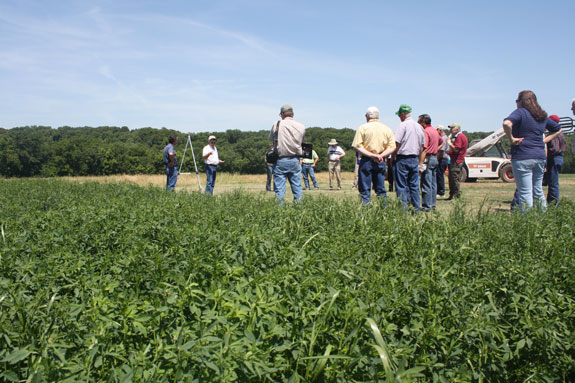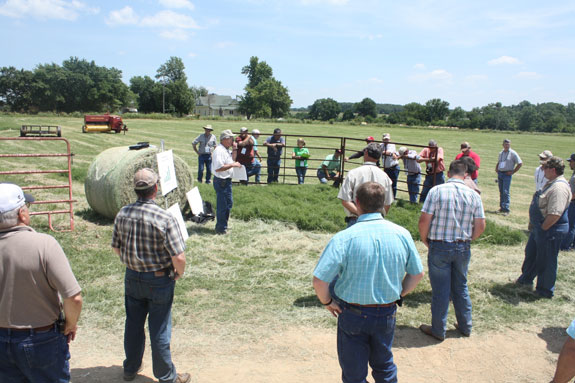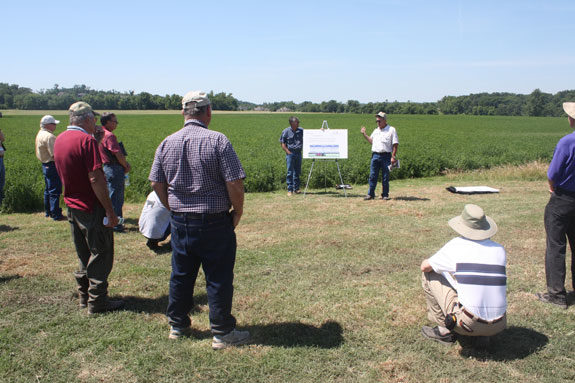About 100 people attended the event sponsored by the Arkansas Forage and Grassland Council.
The first stop was a municipal pollution control facility in Rogers, Arkansas, where biosolids have been applied to mixed forage fields since the 1980s.
For years, the focus was on utilizing bermudagrass at the site to reduce soil nitrogen levels, but more recently the emphasis has shifted to phosphorus management.
Hay producer Bobby Umberson leases the 165-acre site. He established alfalfa stands on most of the ground a few years ago.
Tests have shown that in five cropping years (2007-2012), soil phosphorus levels were reduced by 800 pounds per acre – a feat that could not have been accomplished with grass hay alone, researchers said.
Umberson seeded alfalfa into the existing bermudagrass fields with a no-till drill, and there’s still enough bermudagrass to re-take the fields if the alfalfa dies out.
“That’s the beauty of the system,” said University of Arkansas Extension livestock specialist John Jennings. “It’s a fairly low-risk scheme except for the cost of the alfalfa seed.”
The tour also included visits to two farms growing hybrid bermudagrass varieties.

Larry Miser of Pea Ridge was the first farmer in Benton County to establish the Vaughn variety of bermudagrass in 2001. He was looking for better quality seasonal forage for his bulls, but the new variety worked out so well that he now grows it commercially for the horse market.
He offered tips to fellow producers on preparing fields for planting and controlling weeds.
From there, participants toured the Malone Farm near Hillfill where farmers Dennis and Don Malone have set a high bar for producing Greenfield bermudagrass.
In 2001, the Malone brothers were the first participants in Arkansas’ quality forage program to win the AFGC hay contest’s perennial warm-season grass division with Greenfield bermudagrass.
During the 10-year anniversary of the program, they were recognized for having maintained the highest overall bermudagrass hay quality across all harvest periods.
The third stop on the tour was the Marley Farm near Elkin, a chicken and cattle operation where poultry litter is used to fertilize hay fields.
The farm has 10 broiler chicken houses and about 300 head of beef cattle.
“The cattle complement the poultry operation,” owner Jeff Marley told visitors.
The 540-acre farm includes two miles of river frontage along the White River. It has become an Arkansas “Discovery Farm,” where university researchers are collecting nutrient management and water quality data.
“He is one of the most progressive producers in our county,” UA Washington County Extension Agent Johnny Gunsaulis said of Marley.

At the final stop on the tour, the University of Arkansas’ Watershed Research and Education Center in Fayetteville, participants learned about several research projects, including one that’s evaluating the use of native trees, shrubs and grasses to improve water quality along a riparian corridor.
They also learned about a study that’s examining biomass yields of switchgrass and sorghum fertilized with poultry litter.
The winners of the 2012 AFGC hay contest were also announced on the tour. Arkansas producers continued their domination of the warm-season perennial grass category. This year’s winners were:
Warm-season perennial grasses
- First place – Dan Henderson, Decatur, Arkansas
- Second place – Jimmy Jarvis, Hiwasse, Arkansas
- Third place – John Ginn, Gravette, Arkansas
Cool-season perennial grasses
- First place – John Welch, Charlotte Hall, Maryland
- Second place – Clayton Geralds, Munfordville, Kentucky
Alfalfa
First place – Clayton Geralds, Munfordville, Kentucky
Next year’s AFGC national tour will be held May 22-24, 2013, in Virginia. For more information click here. FG
PHOTOS
Photos by Dave Wilkins.











